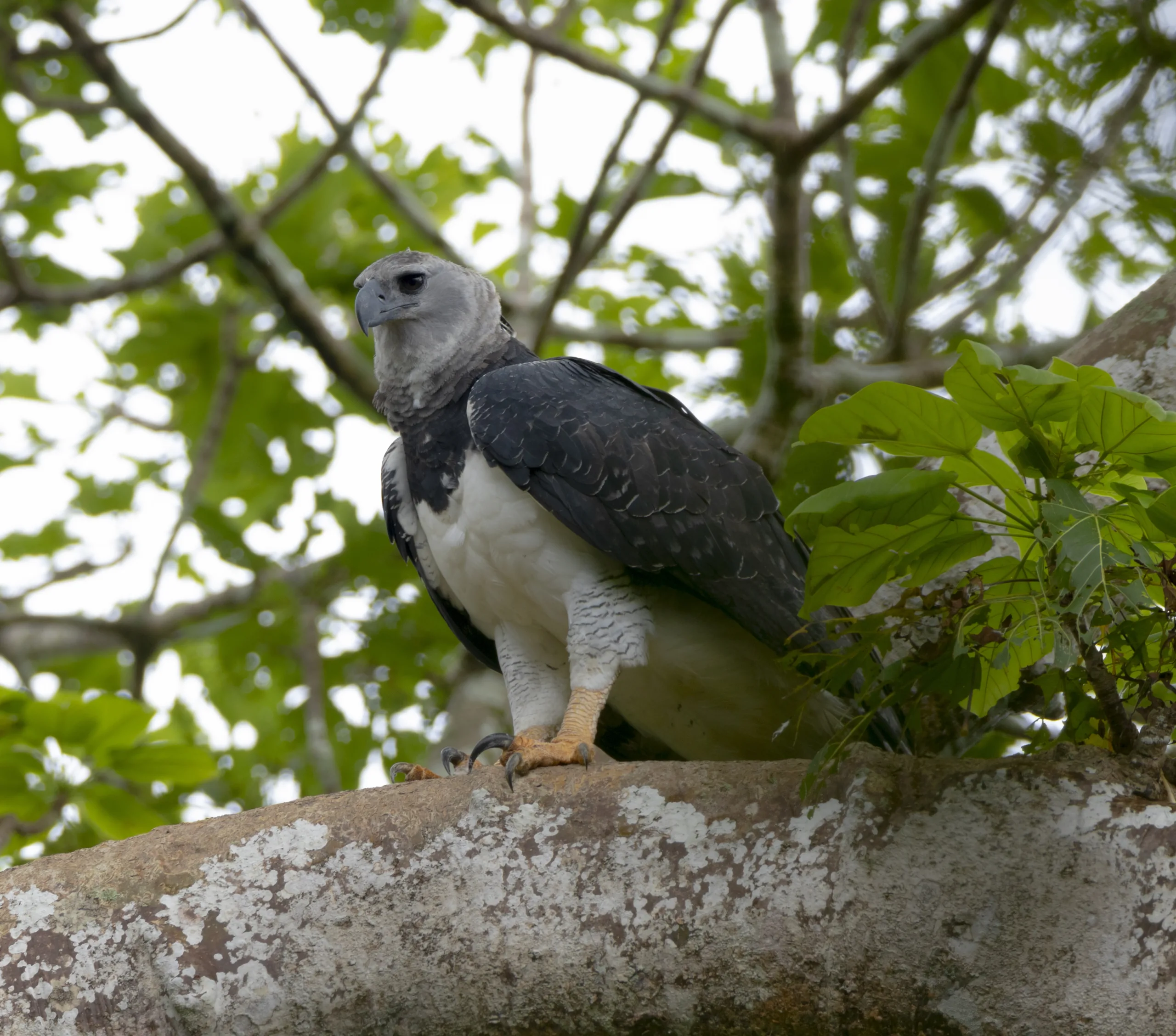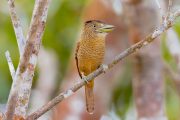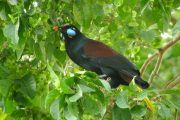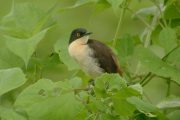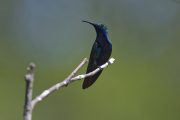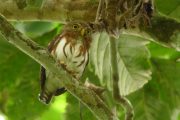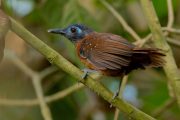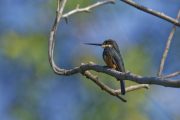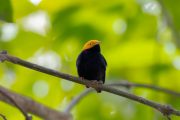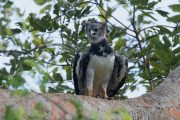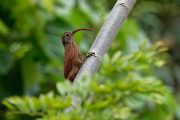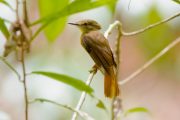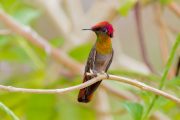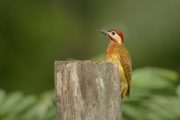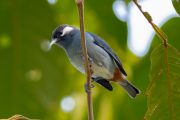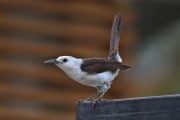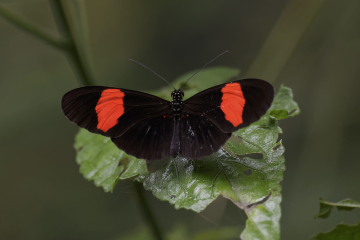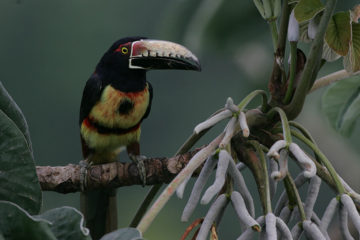7-night, all-inclusive birding package
Darién, as this entire eastern-most region of Panama is called, is perhaps the most diverse and species-rich region of Central America. Long coveted by avid birders as an impenetrable haven for rare species, this region is now readily accessible by a highway extending through the spine of Panama right into the heart of this bird-rich land. During this exciting, highly recommended 7-night adventure, we visit, en route to the Canopy Camp, the Bayano Reservoir, to look for such specialties as the starkly beautiful Black Antshrike, Rufous-winged Antwren and stunning Orange-crowned Oriole. In Darién, we visit large tracts of mature lowland rainforest to seek out Rufous-winged Antwren, Bare-crowned Antbird and Golden-green Woodpecker; and the swampy meadows along the Pan-American Highway, the haunts of the magnificent Spot-breasted Woodpecker! We will enjoy great birding on this Panama wildlife tour through the mature secondary forests, tranquil lagoons and riversides of this region, where we hope to get excellent views of Stripe-throated Wren, Black-collared Hawk, Black-capped Donacobius, Yellow-hooded Blackbird, Large-billed Seed-Finch and others.
After each Panama wildlife tour, we will spend all our nights at Canopy Camp Darien, where we will enjoy comfortable, large, safari-style tent accommodations, each with full-size beds, private bathroom facilities with refreshing showers, flush toilets, electricity from solar panels, and fans. The protected forests of the Filo del Tallo Hydrological Reserve surround the camp. In the vicinity of the camp itself we will enjoy such regional specialties as Gray-cheeked Nunlet, White-headed Wren, Rufous-tailed Jacamar and Pale-bellied Hermit right in the gardens! This Panama wildlife tour offers other surprises, such as Spectacled Parrotlet, Dusky-backed Jacamar, Double-banded Graytail, King Vulture and the majestic Harpy Eagle! You are sure to have the birding adventure of a lifetime!
7 Night Package (2025): High Season: $3,468 — Green Season: $2,417
**add 3 nights at Canopy Tower or Canopy Lodge for only $1,149 (High) or $808 (Green)
7 Night Package (2026): High Season: $3,573 — Green Season: $2,490
**add 3 nights at Canopy Tower or Canopy Lodge for only $1,184 (High) or $833 (Green)
***Packages normally begin on Sundays
Rates in US$ per person (+ taxes), double occupancy
On the first night of this Panama wildlife tour, accommodations will be at the Riande Aeropuerto Hotel or at the Crowne Plaza Panama Airport Hotel in Panama City. Your guide will meet you bright and early (around 6:30 am) in your hotel lobby the next morning to head to the Canopy Camp, where you will stay for the following 6 nights. This is an all-inclusive tour with an active itinerary—daily morning and afternoon guided birding trips are included for the full duration of your Panama wildlife tour. The tour finishes mid-afternoon on the last day in Panama City.
Visiting Darién is truly an adventure, so expect the unexpected and be prepared for excitement around every corner! Our guides know well how to find the regional specialties that live here and how to dodge the ever-changing conditions of the region from season to season. The itinerary, therefore, is very flexible to our guests’ desires and targets and current conditions. Some sites are accessible year-round, while others are only worth visiting and accessible during certain seasons. Regardless, our guides and staff are bound to show you many, many birds and a great experience in the wilderness of Darién!
Panama’s National Bird: The Harpy Eagle
Darién is a stronghold for Harpy Eagles and other large forest raptors, and holds Central America’s largest population of this rare and majestic bird. If there is a site available to visit, whether an active nest or a fledged juvenile in a reliable location, it will be included in the itinerary. We can keep you informed as your trip gets closer. Please keep in mind that we can never guarantee the sighting of a Harpy Eagle (or anything in nature), even at a reliable site, but we will be sure to try if there is a chance!
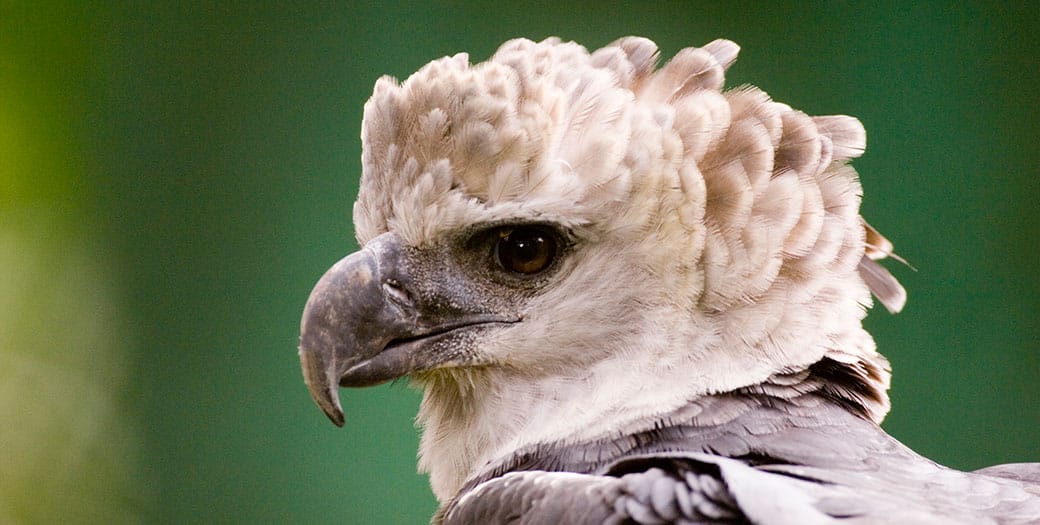
If there is no nest site or juvenile bird to visit, there is still always the chance to come across a Harpy Eagle during your stay. Over the past few years, we have had Harpy Eagle sightings at several of the birding sites we visit, including a few times at the Canopy Camp itself!
Check out our Harpy Eagle & Crested Eagle Logs here:
Harpy Eagles live in remote mature forest, and a full-day trip may be required to visit the site available. The following description gives you an idea of what a Harpy Eagle excursion entails:
The Harpy Eagle is our target for the day! Today we will start very early, long before sunrise, and drive to Yaviza, at the end of the Pan-American Highway. Arriving at dawn in Yaviza, we will board a “piragua”—a dugout canoe—and traverse the still waters of the Chucunaque and Tuira rivers. The river edges offer shrub and grass habitat, as well as mudflats and beaches depending on the water level. There are plenty of birds to see along the riverside: Neotropic Cormorant, Anhinga, Great Blue, Cocoi, Little Blue, Tricolored, Striated and Capped Herons, Snowy Egret, White and Green Ibises, Yellow-crowned Night-Heron, Pied Water-Tyrant, Bronzed Cowbird, Yellow-hooded Blackbird and both Crested and Black Oropendolas. White-tailed Kite and Black-collared and Common Black Hawks may be found cruising overhead.
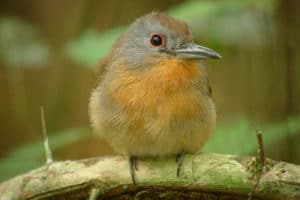
Upon arrival in El Real, we can scan the open areas for Spot-breasted Woodpecker and Great Potoo. We will meet a local truck and head south out of town past the airstrip, to the trailhead at the border of Darien National Park! This trail is wide, traversing through lowland rainforest and alongside a river. If very lucky, we may see Harpy Eagle or Crested Eagle, as both of these magnificent raptors roam the dense forests here. Hopefully with some success this morning, we can rest and have a picnic lunch in the field, and continue to bird along the trail. Other large forest eagles, including Ornate Hawk-Eagle, can also be found in the area, as well as Gray-cheeked Nunlet, White-fronted Nunbird, Green-and-rufous Kingfisher, Agami Heron, Red-throated Caracara, Chestnut-backed Antbird (the eastern Panama race shows white dots on the wings), Chestnut-fronted and Great Green Macaws, Scarlet-browed Tanager and more. After lunch and a break, we will retrace our steps and start our way back to El Real, then head back to Yaviza by river. Along the Pan-American Highway, we can scan for bird activity as the sun sets.
The following are brief descriptions of some of the birding areas you may visit during your Panama wildlife tour at Canopy Camp Darien:
Bayano Lake Area & Torti Area
As we drive along the Pan-American Highway, we will scan for roadside birds and open-field raptors including Savanna Hawk and Crested Caracara. At the bridge at Bayano Lake, a great opportunity awaits to see what we can see along the lakeside. This reservoir supports great numbers of water birds, including a large colony of Neotropic Cormorants, as well as Anhinga, Cocoi Heron and the rare Bare-throated Tiger-Heron. We will scan the water’s edge for Purple Gallinule, Pied Water-Tyrant, Smooth-billed Ani and Ruddy-breasted Seedeater. A short trail leading from the water’s edge is a great place to search for Black Antshrike, Bare-crowned Antbird, Rufous-winged Antwren and Golden-collared Manakin. Just 10 minutes down the road at Río Mono Bridge, the surrounding forest is home to One-colored Becard, Black-headed Tody-Flycatcher, Blue Cotinga, Pied Puffbird, Orange-crowned Oriole, Blue Ground Dove and more. We will also scan the river below for Green-and-rufous Kingfisher and the elusive Fasciated Tiger-Heron. The forest edge and scrubby roadsides around Rio Torti offer good opportunities to see Pacific Antwren, Double-banded Graytail and Little Cuckoo. At a lovely Panamanian restaurant in Torti, the hummingbirds at the feeders will no doubt capture our attention, as Long-billed Starthroat, Sapphire-throated Hummingbird, Scaly-breasted Hummingbird, Black-throated Mango and more take their lunch as well; great hummingbird photo opportunities abound throughout this Panama wildlife tour!
Canopy Camp Grounds & Nando’s Trail
Yellow-throated and Keel-billed Toucans call from the towering Cuipo trees; Red-lored and Mealy Parrots fly overhead; White-bellied Antbird, Bright-rumped Attila, White-headed Wren and Golden-headed Manakin sing from the surrounding forests; while Pale-bellied Hermit and Sapphire-throated Hummingbird visit the flowers around camp. Rufous-tailed Jacamar and Barred Puffbird are also seen frequently around the grounds. We will work our way into the forest on “Nando’s Trail,” in hopes of finding Tiny Hawk, Black Antshrike, Great Antshrike, Olive-backed Quail-Dove, Cinnamon Becard, Black-tailed Trogon, Double-banded Graytail, Gray-cheeked Nunlet, Yellow-breasted Flycatcher, Royal Flycatcher and Russet-winged Schiffornis. We will also be looking for groups of Red-throated Caracara, King Vulture and Short-tailed Hawk overhead in the clearings. Ornate Hawk-Eagle, Plumbeous and Zone-tailed hawks are also possible.
In the open areas, the verbenas are full of hummingbird and butterfly activity, where we hope to see Violet-bellied Hummingbird, Pale-bellied Hermit, Long-billed Starthroat, Blue-throated Goldentail and if lucky, the stunning Ruby-Topaz Hummingbird feeding here. Spot-crowned Barbet, Olivaceous Piculet, White-headed Wren, Red-rumped Woodpecker and Streak-headed Woodcreeper are other birds we may encounter. If desired, we can hike up the slope to stand in the shadows of two giant Cuipo trees.
There will be an opportunity during the week to explore the grounds of the Canopy Camp at night in search of nocturnal birds and mammals, including Black-and-white and Mottled Owls, Great and Common Potoos, Kinkajous, Central American Woolly Opossum and more!
Birding the Pan-American Highway
We will head southeast and bird the forests and swampy meadows along the road toward Yaviza, at the end of the Pan-American Highway! Black-billed Flycatcher, Sooty-headed Tyrannulet, Jet Antbird, Black Oropendola, Pied Water-Tyrant, Bicolored and Black-collared Hawks, Pearl and White-tailed Kites, Limpkin, Spot-breasted Woodpecker, Ruddy-breasted Seedeater, Yellow-hooded Blackbird, Black-capped Donacobius and Red-breasted Meadowlark can all be found as we head further into Darién.
El Salto Road
El Salto Road extends 6 km north from the Pan-American Highway and ends at the mighty Río Chucunaque. This open road and surrounding dry forest is a great place to search for regional specialties including Golden-green Woodpecker, Double-banded Graytail, Blue-and-yellow and Chestnut-fronted Macaws, Black and Crested Oropendolas, Blue Cotinga, White-eared Conebill, Black-breasted Puffbird, Orange-crowned Oriole and the majestic King Vulture. A trail at the end of the road will take us into low-canopy forest, where we hope to find Bare-crowned Antbird, Pale-bellied Hermit, Olivaceous Piculet, Streak-headed Woodcreeper and Forest Elaenia.
Tierra Nueva Foundation
Adjacent to El Salto Road is the property of the Tierra Nueva Foundation. Fundación Tierra Nueva is a non-profit organization whose main mission is “working towards the sustainable development of people of the Darién Rainforest.” The property is the home of a technical school focusing on applications in agriculture. We will explore the trails of this large, forested property, in hopes of finding Streak-headed Woodcreeper, Yellow-breasted and Black-billed Flycatchers, Red-rumped Woodpecker, Slaty-backed Forest-Falcon, Cinnamon, Cinereous and One-colored Becards, White-eared Conebill, White-headed Wren and the magnificent Great Curassow. We will also search for the eastern race of the Chestnut-backed Antbird, which shows white spots on the wings.
Las Lagunas Road (Aguas Calientes) & Aruza Lagoons
This road extends 12 km south off the Pan-American Highway through open farmland, dry scrub and roadside habitat. The road eventually crosses a stream and ends at some small ponds. Along the roadsides, we hope to find Red-breasted Meadowlark, Spot-breasted Woodpecker, Yellow-breasted Flycatcher, White-headed Wren, Smooth-billed and Greater Anis, Muscovy Duck, Rufescent Tiger-Heron, Southern Lapwing, Blue-headed Parrot, Striped Cuckoo, Scaly-breasted Hummingbird, Ringed and Amazon Kingfishers, Buff-breasted Wren, Bananaquit, Giant and Shiny Cowbirds, Crested Oropendola, and Laughing and Aplomado Falcons. If we’re lucky, we may get a glimpse of a Chestnut-fronted Macaw or a shy Little Cuckoo, both having been seen along this road. At the lagoons, we hope to find Pied Water-Tyrant, Capped Heron, the beautiful Yellow-hooded Blackbird and the extraordinary Black-capped Donacobius—this is great habitat for all these wonderful species.
Quebrada Felix
Quebrada Felix—this newly discovered site awaits exploration! Quebrada Felix is nestled in the base of the Filo del Tallo Hydrological Reserve, and is just a short drive from the Canopy Camp. Surrounded by tall trees and mature lowland forest, we will walk the rocky stream in search of some of Panama’s most wanted species, including Black-crowned Antpitta, Scaly-throated Leaftosser, Speckled Mourner, Ocellated Antbird, Rufous-winged and Moustached Antwrens, White-fronted Nunbird, Wedge-billed Woodcreeper, Royal Flycatcher and the endemic Stripe-cheeked Woodpecker. It is also a great spot to find Fasciated Tiger-Heron, Green-and-rufous Kingfisher, Bicolored Antbird, Golden-crowned Spadebill, Double-banded Graytail and much more. Crested and Solitary Eagles have even been spotted here, a great testament to the mature forest of the area. Quebrada Felix is becoming a favorite spot among our guides and recent visitors!
Lajas Blancas
On this Panama wildlife tour, we eagerly explore the open areas and mixed forests of the area of Lajas Blancas. Lajas Blancas is the closest Embera community to the Canopy Camp, a large town with a population of over 1000 residents. Just 15 minutes away, the area around the community boasts great birding and the opportunity to find many Darien specialties! After turning off the Pan-American Highway, we drive through pasture and open farmland—a great place to see One-colored Becard, Great Potoo, Spot-breasted Woodpecker, Yellow-crowned Tyrannulet, Yellow-breasted Flycatcher, Black Antshrike and Black Oropendola. During the dry season, a bridge across the Chucunaque River provides us easy access to some mature secondary forest where Double-banded Graytail, Rufous-tailed Jacamar, White-winged and Cinnamon Becards, Cinnamon and Golden-green Woodpeckers, manakins and others can be found. Beyond the community, the road continues and there is much more forest, including primary forest at its far reaches, waiting to be explored on your Panama wildlife tour.
Nuevo Vigia
We are off to Nuevo Vigia, an Embera community nestled north of the Pan-American Highway, surrounded by great secondary growth dry forest and two small lakes, all of which attract an enticing variety of birds. The community is accessible by “piragua,” a locally-made dugout canoe. As we coast along the Chucunaque and Tuquesa Rivers, we will keep our eyes and ears open for Chestnut-backed, Crested and Black Oropendolas, Spot-breasted Woodpecker, Common Black Hawk, Yellow-tailed Oriole, Red-billed Scythebill, Capped and Cocoi Herons, White Ibis, Greater Ani, Solitary Sandpiper and other water birds. We will spend the majority of the morning birding a trail toward a small lagoon, a great place to see Black-collared Hawk, Bare-crowned and White-bellied Antbirds, Green Ibis, Gray-cheeked Nunlet, Spectacled Parrotlet, Black-tailed Trogon, Striped Cuckoo, Black-bellied Wren, Little Tinamou, Golden-green Woodpecker and Green-and-rufous Kingfisher! In the town of Nuevo Vigia, local artisans weave colorful decorative masks and plates out of palm fronds and carve cocobolo wood and tagua nuts into animals and plants, and we will have the opportunity to meet some of the community members and admire and purchase some of the beautiful products they make by hand. We will enjoy a satisfying picnic lunch in the village, followed by more great birding around the riversides and scrubby habitat surrounding Nuevo Vigia before heading back to the Canopy Camp.
Aligandi
Aligandi is a huge area with unique scrub forest and much to be explored. We head out from the Camp toward the end of the Pan-American Highway, taking a turn prior to reaching Yaviza. Along the roadsides here, we scan for Red-breasted Meadowlark, Striped Cuckoo, Ruddy-breasted Seedeater, Thick-billed Seed-Finch, American Kestrel and other open area birds. A Great Green Macaw nest is tucked up in the canopy of a huge Cuipo tree, visible from the road, and if lucky, an adult or a chick may be seen poking its head out of the cavity. At Finca Doncella, we continue on foot along the road through the scrub forest, seeking out Spot-breasted Woodpecker, Bat Falcon, Giant Cowbird, Orange-crowned Oriole, Red-billed Scythebill, White-eared Conebill and mixed feeding flocks. It is possible to see macaws flying over as we further explore the area on this Panama wildlife tour.
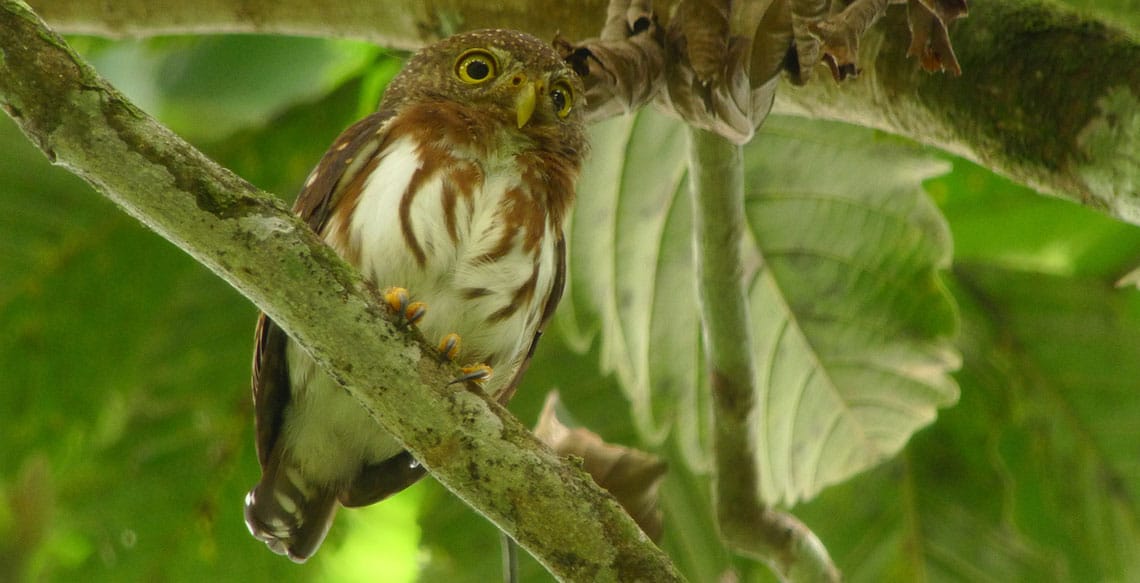
Please note that the itinerary is flexible, and may change without prior notice due to weather, alterations in habitat or other conditions.
Canopy Camp
Our Canopy Camp in Darién, Panama is a birder’s paradise. The protected Darién jungle provides a stronghold for Great Green Macaw, Great Curassow and the majestic Harpy Eagle, Panama’s national bird, as well as other endangered wildlife including Colombian Spider Monkey, Baird’s Tapir and America’s most powerful cat, the Jaguar. Some of Panama’s endemic species, such as the Pirre Warbler, Pirre Bush-Tanager and Beautiful Treerunner, are only found here in the far reaches of the Darién Province.

